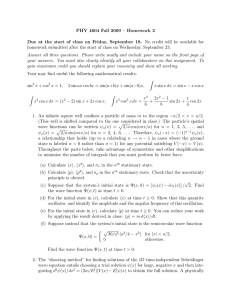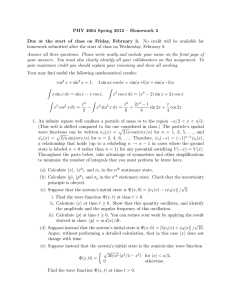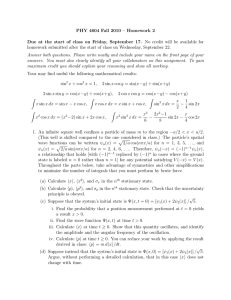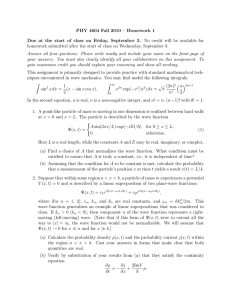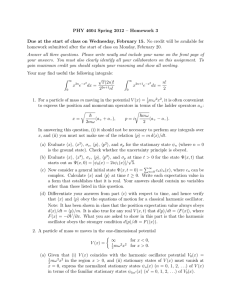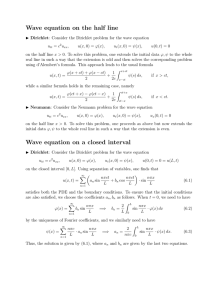PHY 4604 Fall 2008 – Homework 2
advertisement
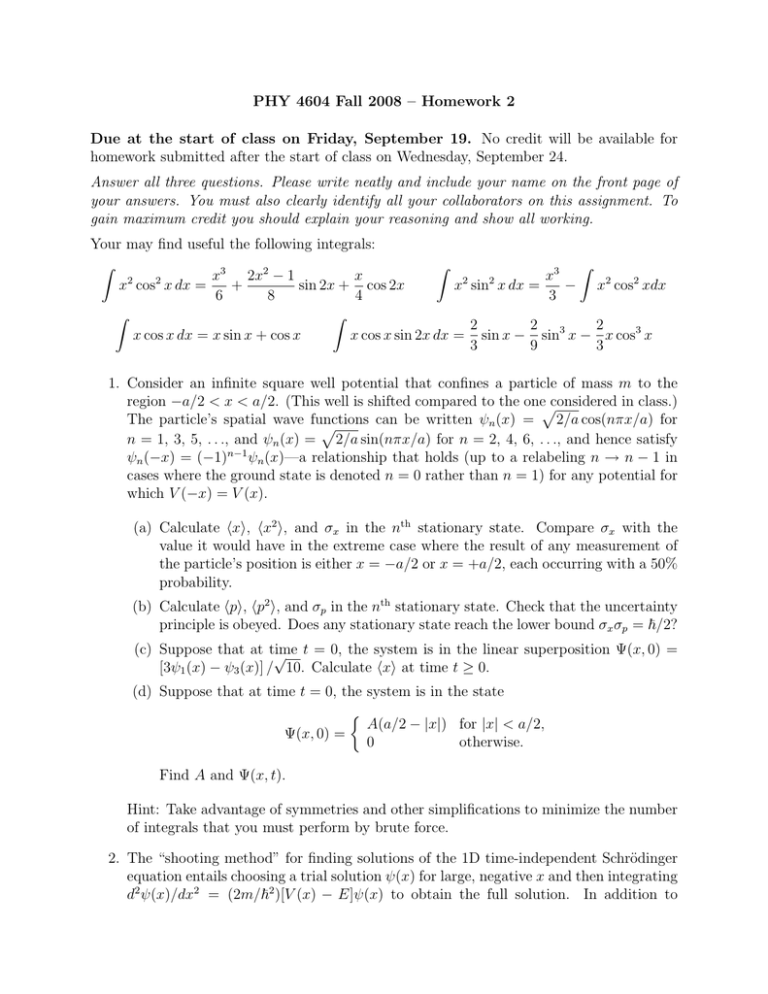
PHY 4604 Fall 2008 – Homework 2 Due at the start of class on Friday, September 19. No credit will be available for homework submitted after the start of class on Wednesday, September 24. Answer all three questions. Please write neatly and include your name on the front page of your answers. You must also clearly identify all your collaborators on this assignment. To gain maximum credit you should explain your reasoning and show all working. Your may find useful the following integrals: Z Z Z x x3 2x2 − 1 x3 2 2 2 2 x cos x dx = + sin 2x + cos 2x x sin x dx = − 6 8 4 3 Z Z 2 2 x cos x dx = x sin x + cos x x cos x sin 2x dx = sin x − sin3 x − 3 9 x2 cos2 xdx 2 x cos3 x 3 1. Consider an infinite square well potential that confines a particle of mass m to the region −a/2 < x < a/2. (This well is shifted compared to the onepconsidered in class.) The particle’s spatial wave functions can be written ψn (x) = 2/a cos(nπx/a) for p n = 1, 3, 5, . . ., and ψn (x) = 2/a sin(nπx/a) for n = 2, 4, 6, . . ., and hence satisfy ψn (−x) = (−1)n−1 ψn (x)—a relationship that holds (up to a relabeling n → n − 1 in cases where the ground state is denoted n = 0 rather than n = 1) for any potential for which V (−x) = V (x). (a) Calculate hxi, hx2 i, and σx in the nth stationary state. Compare σx with the value it would have in the extreme case where the result of any measurement of the particle’s position is either x = −a/2 or x = +a/2, each occurring with a 50% probability. (b) Calculate hpi, hp2 i, and σp in the nth stationary state. Check that the uncertainty principle is obeyed. Does any stationary state reach the lower bound σx σp = ~/2? (c) Suppose that at time √ t = 0, the system is in the linear superposition Ψ(x, 0) = [3ψ1 (x) − ψ3 (x)] / 10. Calculate hxi at time t ≥ 0. (d) Suppose that at time t = 0, the system is in the state A(a/2 − |x|) for |x| < a/2, Ψ(x, 0) = 0 otherwise. Find A and Ψ(x, t). Hint: Take advantage of symmetries and other simplifications to minimize the number of integrals that you must perform by brute force. 2. The “shooting method” for finding solutions of the 1D time-independent Schrödinger equation entails choosing a trial solution ψ(x) for large, negative x and then integrating d2 ψ(x)/dx2 = (2m/~2 )[V (x) − E]ψ(x) to obtain the full solution. In addition to being normalizable, a physically acceptable solution must be continuous everywhere. Furthermore, dψ/dx must be continuous everywhere except at the location x = xj of any infinite jump in V (x), where ψ(xj ) = 0 is the only solution. We can use the shooting method to find a qualitative picture of solutions ψ(x) in many cases where obtaining a full analytical solution would be messy or even impossible. Consider a particle of mass m confined v 0 V (x) = ∞ by the potential for |x| < a/6, for a/6 < |x| < a/2, for |x| > a/2. Answer the questions below using qualitative arguments, not detailed calculations. The wave functions ψa , ψb , and ψc defined in parts (a)–(c) should all be sketched (not plotted) and clearly labeled on the same graph, with a brief explanation elsewhere of how you reached your answers to (b) and (c). To set the horizontal p and vertical scales of the graph, label ±a/2 and ±a/6 on the x axis, and label ± 2/a on the ψ axis. (a) Sketch ψa (x), the (normalized) ground-state (n = 1) wave function for the case v = 0 where the potential reduces to the infinite square well. (b) Now consider the case v ' ~2 π 2 /(10ma2 ). Let ψb (x) be the solution of the timeindependent Schrödinger equation for this v > 0 that coincides exactly with the v = 0 solution ψa (x) throughout the region x < −a/6. Plot the qualitative form of ψb (x) over the entire range −a/2 < x < a/2. It is likely that ψb (x) is not properly normalized, but this shortcoming can easily be rectified. Give another reason why ψb (x) is not a physically valid spatial wave function for this potential. (c) Sketch ψc (c), the (normalized) ground-state wave function for the value of v considered in (b). Make clear the qualitative differences between ψc (x) and the other two wave functions that you have sketched. (d) Will the ground-state energy be greater or smaller for v > 0 than for v = 0? Briefly explain your reasoning. (e) Will the probability density at x = 0 be greater or smaller for v > 0 than for v = 0? What about the probability density at x = (1 − )a/2, where is an arbitrarily small positive number? In each case, briefly explain your reasoning. 3. For a particle of mass m moving in the potential V (x) = 12 mω 2 x2 , it is often convenient to express the position and momentum operators in terms of the ladder operators a± : r r ~ ~mω (a+ + a− ), (a+ − a− ). x= p=i 2mω 2 (a) Evaluate hxi, hx2 i, σx , hpi, hp2 i, and σp for the stationary state ψn (where n = 0 is the ground state). Check whether the uncertainty principle is obeyed. (b) Evaluate hxi, hx2 i, σx , hpi, hp2 i, and σp at √ time t > 0 for the state Ψ(x, t) that starts out as Ψ(x, 0) = [ψ0 (x) − 2iψ1 (x)]/ 5. Hint: It should not be necessary to perform any integrals over x.
